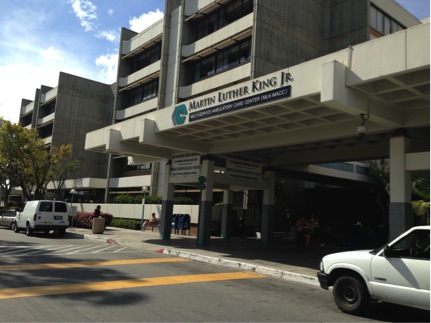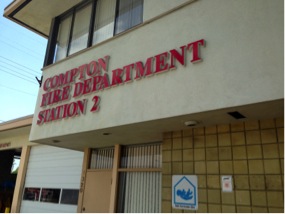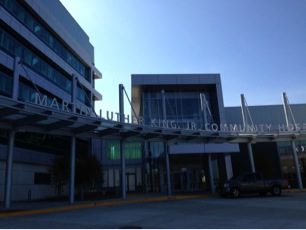Community Reacts To New South L.A. Hospital With No Trauma Center

Sitting in the hospital lobby waiting for her name to be called, Ernestine Singleton said she has seen it all over the past 30 years as a patient of the Martin Luther King, Jr./Drew Medical Center.
“I’ve been coming here since they first opened up the hospital,” Singleton said. “I have never had any problems with the service. They have treated me and my daughters, who were both born here. I’ve loved it, and I think they have some of the best doctors here.”
SEE ALSO: Will A New South L.A. Hospital Mend Old Wounds?
King/Drew is gone; the Martin Luther King, Jr. Multi-Service Ambulatory Care Center is the last surving monument to a hospital that once served more than 1.2 million residents in Willowbrook, Watts and Compton. With the hospital's closure in 2007, many people, including Singleton, have been forced to travel 15 to 20 miles to reach the nearest full-service hospital with ambulatory care.
“I’ve personally had to go through a lot of changes going farther out to have to get treated since they’ve closed it down,” Singleton said. “I go to Harbor in Torrence three to four times a month, and it takes me two-and-a-half to three hours to get there in traffic.”
Fifteen to 20 miles may not seem that far, but if you’re on your deathbed, every minute counts and is something not to be taken for granted.
“I think them making this hospital only a multi-service center was the worst decision they could’ve made,” said Singleton, who would like to see the hospital reopen. “There are a lot of people that are not getting medically treated because of the long distances they have to travel. The hospital served a lot of people.”
SEE ALSO: Non-Emergency Medical Service: What Happens When South L.A. Calls 911
Willie Brown, another South L.A. resident, said he has been going to King/Drew since the '70s. A scar reveals where doctors took the bone and bullet out of his left forearm to save his life. He had been shot multiple times in the arm, back and leg after being robbed. The need for a full-service hospital is big, he says. Brown hears similar occurrences of gunshots and stabbings “very frequently” in the neighborhood.
“People get hurt every day around here,” Brown said. “They are a lot of people associated with gangbangers, all this ‘red is better than blue.’ You don’t get an extra life. When it’s gone, that’s it.”
There has been a sense of hope in the air since the start of its construction. The Martin Luther King, Jr. Community Hospital, the new full-service hospital, is scheduled to open a few yards away from the ambulatory center. The Martin Luther King Jr. Los Angeles Healthcare Corporation, an independent nonprofit organization, will govern the hospital.
It looks to make stark improvements from the former King/Drew by offering advanced and innovative healthcare technology. It will provide inpatient primary care, basic emergency services, health education and outreach services. But, even with all of these additions, many wonder: Is that enough?
“If I would have gotten shot, stabbed or hit by a car, I would have told them to take me to ‘Killer King’ in a minute because they had the best trauma center around,” Brown said. “If you came in[to the hospital] with a cold, you might die. But if you came in with a gunshot or wound, you’d be okay.”
SEE ALSO: Compton Medics Recall 'Killer King' With Fondness

Luis Hernandez, a fire Captain at Fire Station 2 in Compton, would agree that the King/Drew trauma center was one of a kind. Although now working as a supervisor assigned to the engine and paramedic unit, he used to work as a firefighter paramedic. As a paramedic in the early 2000s, he would ride in the ambulances, quickly responding to emergency situations in the Watts, Compton and Willowbrook areas.
“MLK was a hospital in an area that is underserved,” Captain Hernandez said. “We have a lot of trauma here. We see a lot of bad things happen. And in our business, time is of the essence.”
Without a current nearby trauma center, many of the paramedics and local residents are forced to travel a greater distance to reach Harbor UCLA Medical Center or St. Francis Medical Center in Lynwood.
“We call it the golden hour,” Captain Hernandez said. “If we can transport a patient within one hour of a trauma call, then their chances of a better outcome increases significantly.”
When King/Drew was still open, paramedics had a trauma center right next door to them. But with the only options now being St. Francis Medical Center—a much smaller hospital—and Harbor UCLA Medical Center, he said it now takes up to 20 to 25 minutes in traffic to reach their destination. So although there are still trauma centers, they are not only farther, but they are also becoming more crowded and, as a result, have fewer beds available to treat patients.
“I went to the [Harbor] emergency room and I sat almost two days before I got in because they are so overcrowded,” Singleton said. “That’s how bad the emergency room is there because people have to go far out [to get service].”
“Obviously [King/Drew] closed down for a reason,” Captain Hernandez said. “But when it comes to handling trauma, I think they did that very well. Their closing was the disappointing part. We got rid of one of the better trauma centers because of what was going on at the regular hospital.”
SEE ALSO: Will A New South L.A. Hospital Mend Old Wounds?
The need for a new trauma center in the area is great, but it turns out that is not something the new Martin Luther King, Jr. Community Hospital will provide.
“I think they missed the most important part of the capabilities of the [Martin Luther King, Jr. Community Hospital] in the location,” Captain Hernandez said. “You’re talking about Watts, Compton and the South Central area, and the propensity of trauma is way up there.”

Not only will the new hospital be unable to service traumas, but the same goes for heart attacks and strokes. To treat such life-threatening ailments, the hospital would have to become a STEMI-receiving hospital.
“We’re always happy to accept more hospital beds,” Captain Hernandez said. “I’d think that eventually they would work to become a STEMI center, but right now it really doesn’t help us much. We’d be bypassing.”
Captain Hernandez isn’t the only one who might overlook the new hospital. Local resident, Estela Garnica, has been working across the street from King/Drew for more than 11 years at a laundromat and said she’s never been to the local medical center. She instead takes her daughters to the nearby St. John’s clinic, which is owned and operated by the St. Francis Medical Center, for check-ups and its related hospital for emergencies. Even with the new area hospital’s anticipated opening, she doesn’t plan on visiting anytime soon.
“I would want to hear from people who go there first [before taking my daughters] to see if it’s changed or has gotten better,” Garnica said. “If I heard some good comments, of course I’d go, but I don’t want to be the first one and have something happen to me. So until I see somebody that I know go there, you won’t see me there.”
Compton resident, Demetrius Smith, who was born in the King/Drew hospital, said he only goes to the King/Drew center to pick up his prescriptions. But as for any medical services, he said he would continue to travel 30 minutes to Kaiser Permanente Medical Center to get his medications, even though the new hospital will be closer.
“I’d go to Kaiser because they’re better,” Smith said. “It’s about quality. You just want people to take care of you.”
SEE ALSO: The Disparity Of Healthcare Services In L.A. County
When it comes to emergencies or everyday care, the new hospital may not have the backing of the community, especially if it can’t offer what the community prized most—its trauma center.
“It will basically be like a big clinic without one,” Smith said. “They need to have a trauma center. They need that.”
But even with the uneasiness of many in the community about its opening and desire for more care, others are still optimistic about the future.
“I haven’t stopped coming [to King/Drew] and I’m not going to stop,” Singleton said. “They just need to keep doing what they’re doing because eventually people will get tired of traveling further out and they will start coming back. It does seem like people are starting to come back.”
The new Martin Luther King Jr. Community Hospital is set to open in 2015. Many of the services provided by the multi-service ambulatory center will be transferred to the new Martin Luther King Jr. Outpatient Center, which recently launched on May 28.
Reach contributor Kalyn Norwood here.



